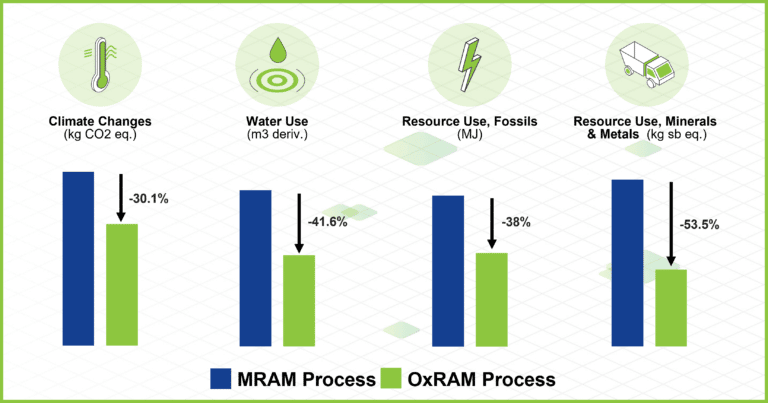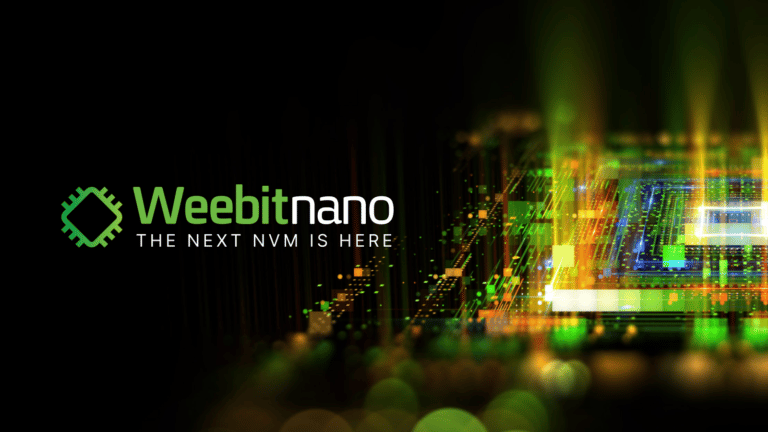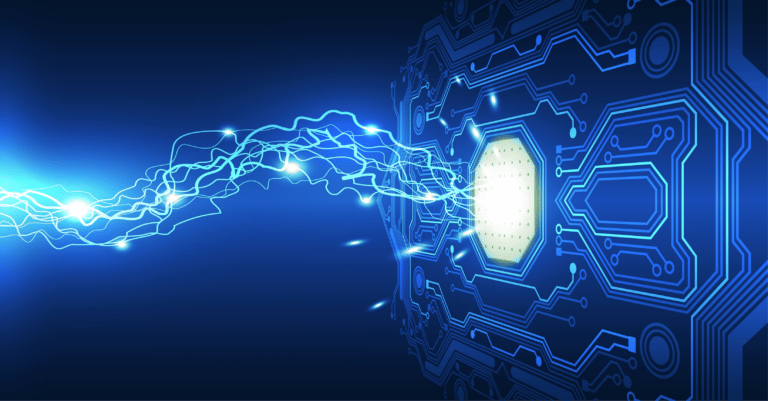
One of the key advantages of Weebit ReRAM (RRAM) is the technology’s ultra-low power consumption. Some of this advantage is due to the inherent features of the technology, and some of it is due to smart design. In this article we’ll explain why customers need a low power non-volatile memory (NVM) and what makes Weebit ReRAM lower power than other types of NVM. We’ll also explain a bit about some of the design techniques and levers that customers can use to adjust the power.
Why is low power consumption important?
In our rapidly warming climate, it has become critical to minimize carbon emissions, and this includes reducing the power consumption of everything we touch – from our homes to our cars to our personal electronic devices and beyond. This is now a key consideration at the government level in many countries, and is a key consideration for institutional investors.
At the practical level, for companies developing electronic products, low power consumption is often a key consideration, especially when it comes to battery operated IoT devices with Bluetooth® Low Energy or energy harvesting technology, and medical devices such as wearables and implantables.
Such devices must ensure that data gathered by tiny sensors is regularly and reliably delivered, often from remote or inaccessible locations. For many of these applications, whether in medical, transportation, agriculture, or other applications, reliability can have life or death consequences. Long battery life – supporting applications that last up to 10-15 years on one battery – is critical.
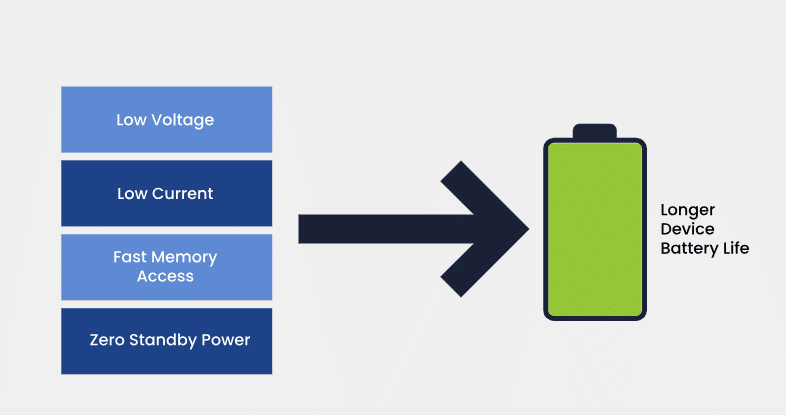
Above: Various ultra-low power attributes of Weebit ReRAM lead to longer device battery life.
Even for products that are plugged into power, designing for low power can be an important consideration. Developers want to avoid costly fans and heat sinks, reduce overall electricity costs, and meet consumer product energy efficiency standards including certifications like Energy Star and LEED for products and buildings, as well as EU energy efficiency labeling. Such guidelines consider not only active power consumption, but also ‘leakage’ power consumed when a product is not in use.
The Role of NVM in Reducing Power Consumption
While NVM may not contribute as much to system power consumption as other components such as the CPU, connectivity modules or display, reducing its impact is a key goal for an overall power management strategy.
As part of a system, choosing ultra-low-power NVM helps to enable longer battery life, leading to improved energy efficiency and longer use times between recharges or battery replacements. It can also lead to better thermal management and overall greener technology. Importantly, by reducing power consumption, the memory subsystem can allocate more power to other critical components, such as the processor or display, improving overall system performance.
When it comes to NVM, there are various factors that contribute to power consumption, such as the power consumed by Read and Write operations, standby power, access frequency and overall system design. Let’s look at some of these in a bit more depth.
Read Power Consumption
In an NVM ‘Read’ operation, data is retrieved from a specific memory location. This includes decoding the address to identify the specific memory location to be accessed, retrieving the data, and outputting the data for processing elsewhere in the system. The ‘Read’ operation is the most common NVM operation, happening many more times than programming the cells, and thus consuming more power.
The power consumed during a Read operation depends on several key factors. One of these is the power supply used. Flash and some other types of memory require a special high voltage supply. Weebit ReRAM is able to read out of a low-voltage power supply – the same one that any system needs for basic calculations. With Weebit ReRAM, there is also no need for an always-on charge-pump – something that is needed with flash memory.
Another contributing factor is cell reading voltage and current. The cell reading voltage refers to the voltage level applied to a memory cell during the read operation. Different memory technologies have specific voltage requirements for reading data from their cells, and these can vary based on the specific memory technology, fabrication process, and design considerations. With Weebit ReRAM, a Read operation is performed using only the digital core voltage (VDD), and the Read cell voltage for ReRAM is typically a few hundreds of millivolts (mV) or lower.
The typical Read cell voltage requirements for other NVMs are higher, typically in the range of 1 to 3V for flash, and several hundred mV to a few volts for MRAM. Weebit ReRAM also has a dedicated “read-only-mode” during which program voltage can be completely shut-off.
These are just a few considerations in terms of Read power consumption. Other important things that impact Read power include:
- The number of data bits read in parallel, including error correction code (ECC) bits: Weebit’s ReRAM architecture is flexible to support different word widths based on the system architect’s preference.
- Memory array capacitance: In Weebit ReRAM, the bitline capacitance is reduced due to array segmentation.
- Sense-amplifier efficiency: Weebit’s engineers have innovated and optimized the sensing circuitry to consume extremely low power per bit.
- Control logic and self-timing circuitry: Weebit ReRAM has a single-ended Read operation with self-timing to enable the operation to terminate as soon as it is complete.
Fast Read times in Weebit ReRAM also allow Execute-In-Place (XiP) to further save system power. We will cover this in a future article.
Write (Program) Power Consumption
In an NVM Write operation, data or instructions are stored or updated to a specific location. This is a complex operation encompassing many events which, of course, consume power. Power consumed during programming is mainly dependent on:
- The number of data bits to be programmed
- The power supply used during SET and RESET operations
- The current through the cell during the SET/RESET operation
- The write circuitry (LDO, limitation, termination) efficiency
- The ability to shut off the power as soon as the operation has completed
In terms of the number of data bits to be programmed, one of the key advantages that ReRAM and other emerging NVMs have over flash memory is that these technologies do not require a sector erase. With flash, even if you just want to erase one bit, you actually must erase the entire sector or segment, and before erasing that sector, you first have to program all the new bits including those that didn’t even need to be programmed. This is obviously a lot of extra work and power. Designers working with flash have found ways to work around the challenge and mitigate the penalties associated with the extra programming and erasing, but even with these workarounds, emerging memories like ReRAM are significantly more power efficient.
With ReRAM, using its direct program/erase capability and byte addressability, the programming is bit-wise: each bit can be independently and selectively SET or RESET. Importantly, with Weebit ReRAM, a programming algorithm does a comparison to existing data to avoid unnecessary writes and then masks out the bits that do not need to be reset.
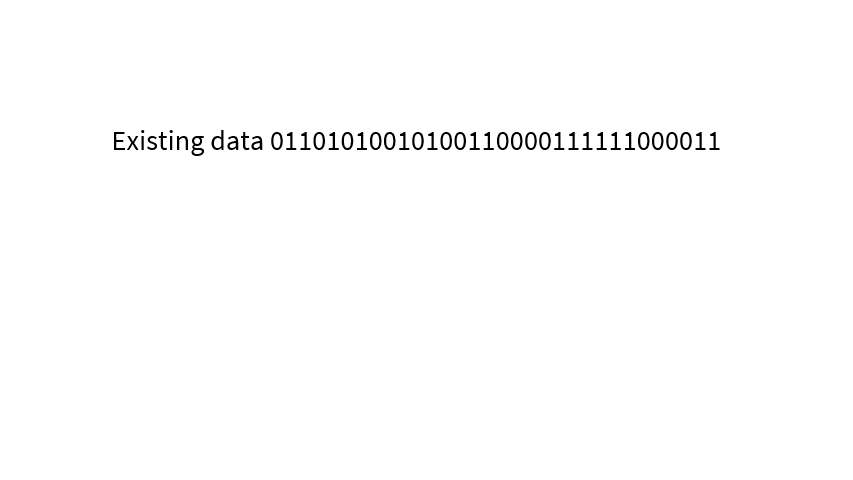
Above: A programming algorithm compares new data to existing data and only resets the new bits.
The programming algorithm also splits Words into Sub-Words to control peak power consumption to mitigate against any issues such as IR-drop or power supply failure. Weebit ReRAM implements smart programming algorithms that control voltage, current and pulse duration during the Write operation, enabling efficient usage of resources.
Flash memory often requires high voltages for programming, sometimes requiring voltages generated by a charge pump or DC-DC converter. These types of converters add area to chip, add cost to the system and waste power. With Weebit ReRAM, programming is ultra-low-power, capable of being done using a lithium cell battery. It also requires low voltages (using a ~3V supply) with no charge pump needed when a ~3V IO voltage is available.
As with a Weebit ReRAM Read operation, Smart algorithms enable the shortest possible Write time and a termination mechanism shuts off the programming pulse as soon as the cell is flipped.
Standby/Sleep/Power-Down Modes
Depending on their specific application and operation, a key design consideration for customers is how often the memory can be in programming mode, standby mode, sleep mode, or very deep power-down mode.
During the inactive states of the system, there is significant cell leakage when using a volatile memory such as SRAM. Similarly with DRAM there are “hidden” refresh cycles that consume power during these states. With any non-volatile memory, there is close to zero power consumption used for retaining the data during inactive states. Like other NVMs, Weebit ReRAM is able to be completely powered down to zero leakage while maintaining stored data. The fact that ReRAM does not require an always-on charge pump makes this advantage even more evident.
The wake-up time of a memory from deep power-down mode to active is also a key factor. A memory that can wake up rapidly from power-down mode to read (or programming) mode allows the system architect to put the memory to sleep even during shorter activity breaks. Said another way, waking up quickly means the system can also go to sleep more often. Again, not having a charge-pump makes this advantage even more meaningful as charge-pumps are known for their slow and power-hungry wake-up times.
Weebit engineers are focused on continuing to reduce the time needed for our ReRAM to wake up from very deep power-down mode. The time is already very fast to switch from power-down to standby mode, and we are in the process of further reducing this by orders of magnitude.
We are focused on providing customers with flexibility when it comes to their choices. One of the benefits of working with Weebit is that our designers are experts at optimizing these parameters and we are willing and able to work with customers to help them optimize their designs to balance performance and power consumption as well as other parameters. If you’d like to learn more about Weebit’s design expertise, read this recent blog on our smart algorithms.
Ultra-low-power NVM
While the factors impacting NVM power consumption can vary widely based on application, Weebit ReRAM is shown to consume significantly less Read, Write and Standby power than embedded flash and other NVMs, contributing to longer battery life for many devices. The low voltage levels used for memory transactions, coupled with its fast memory access time, greatly reduce the overall power consumed by Weebit ReRAM.
Weebit is also shown to be a ‘greener’ type of NVM compared to other technologies. An environmental initiative we completed with our partner CEA-Leti earlier this year examines the environmental impact of Weebit ReRAM compared to MRAM. You can read about that study here.








